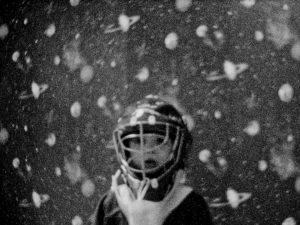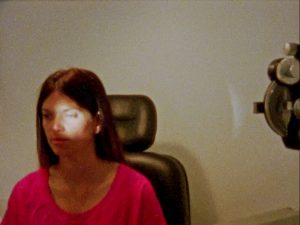Orbits: The Moving Beauty of Disability
Sarah Seené’s latest short documentary plunges us into the luminous gaze of a visually impaired woman.
From the opening images, we are introduced to a captivating character. The dialogue and the complicity between the director and her protagonist create a moving narrative that offers the viewer a range of nuances about Marie-Christine and her visual disability. Orbits (Orbites) tells the story of a young Québécoise woman who has been visually impaired since she was 30. The director chooses to focus primarily on the visual environment of her characters. Marie-Christine is a mother to a young boy, Liam, who is also visually impaired.

Breaking away from the conventional and often patronizing portrayals of people with disabilities, Sarah Seené offers a new and luminous representation. Her images show the different visual and luminous representations that Marie-Christine’s gaze conveys. As we learn from Marie-Christine, “most visually impaired people have some residual vision, it’s rare to see a non-seeing person plunged into complete darkness. In my case, I only have light perception.” Throughout the 23-minute film, the representation and coloration of the image on screen define the different visual sensations of the protagonist. The director lends us the eyes of the visually impaired woman and invites us to see trees, objects, people, lights, and sensations in her way.

Seené reveals that she used two Super-8 cameras for filming and a 16 mm camera to create analog special effects on an optical printer. “The image resulting from analog manipulation moves away from the high-definition renderings of digital technology. I also chose to film out of focus at certain moments so that the viewer’s eye focuses on shapes and colors rather than objects or bodies,” adds Seené. A daring but successful gamble, as Orbits offers an original and authentic aesthetic. A discovery in the construction of the image. The director also takes pleasure in drawing inspiration from the title of her film to build her cinematography. Orbit belongs to the lexical field of the eye and also echoes the cosmos, the universe, and the galaxy, which appear throughout the film. Another symbolic aspect : the film presents the protagonist but also two beings present in her life who evolve in orbit around her.
If the viewer manages to immerse themselves in Marie-Christine’s visual world, it’s also due to the strength of staging. The different plans and camera movements make the protagonist accessible. Her uncomplexed confidences allow us to break down barriers and challenge preconceived ideas about people with disabilities. The narrative approach is a conversation between the protagonist and the author. We hardly hear the author, who, of course, leaves all the space to her subject.

Marie-Christine’s descriptions of objects, plants, animals, and feelings are so intense and precise that one wonders if she sees better than people with normal vision. The musical choice suits this colorful, luminous, jovial, and tender atmosphere, which translates the experiences of moving and special individuals. But Marie-Christine didn’t want to be special. She just wanted to be normal.
By Pélagie Ng’onana
Edited by Steffen Moestrup
Copyright FIPRESCI
